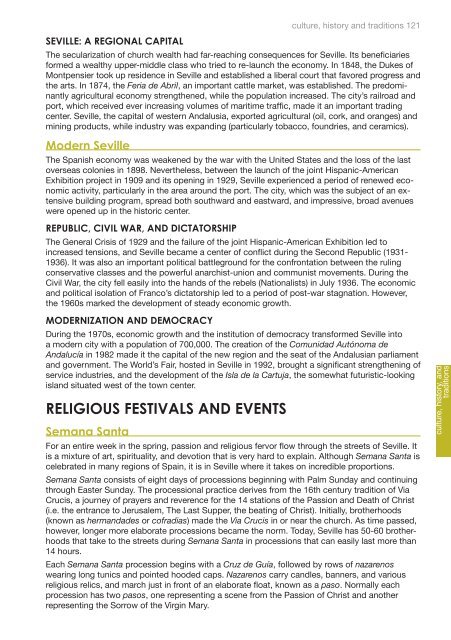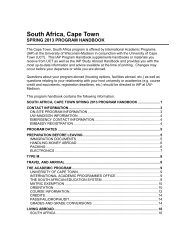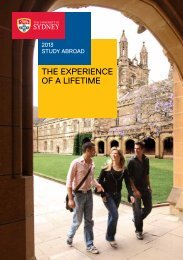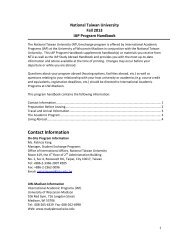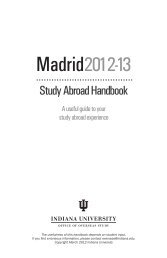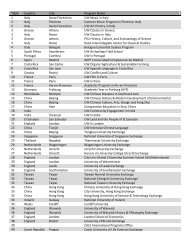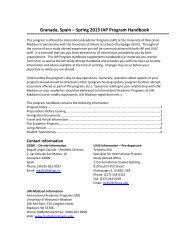teach in spain - UW Study Abroad
teach in spain - UW Study Abroad
teach in spain - UW Study Abroad
You also want an ePaper? Increase the reach of your titles
YUMPU automatically turns print PDFs into web optimized ePapers that Google loves.
Seville: A Regional Capital<br />
culture, history and traditions 121<br />
The secularization of church wealth had far-reach<strong>in</strong>g consequences for Seville. Its beneficiaries<br />
formed a wealthy upper-middle class who tried to re-launch the economy. In 1848, the Dukes of<br />
Montpensier took up residence <strong>in</strong> Seville and established a liberal court that favored progress and<br />
the arts. In 1874, the Feria de Abril, an important cattle market, was established. The predom<strong>in</strong>antly<br />
agricultural economy strengthened, while the population <strong>in</strong>creased. The city’s railroad and<br />
port, which received ever <strong>in</strong>creas<strong>in</strong>g volumes of maritime traffic, made it an important trad<strong>in</strong>g<br />
center. Seville, the capital of western Andalusia, exported agricultural (oil, cork, and oranges) and<br />
m<strong>in</strong><strong>in</strong>g products, while <strong>in</strong>dustry was expand<strong>in</strong>g (particularly tobacco, foundries, and ceramics).<br />
Modern Seville<br />
The Spanish economy was weakened by the war with the United States and the loss of the last<br />
overseas colonies <strong>in</strong> 1898. Nevertheless, between the launch of the jo<strong>in</strong>t Hispanic-American<br />
Exhibition project <strong>in</strong> 1909 and its open<strong>in</strong>g <strong>in</strong> 1929, Seville experienced a period of renewed economic<br />
activity, particularly <strong>in</strong> the area around the port. The city, which was the subject of an extensive<br />
build<strong>in</strong>g program, spread both southward and eastward, and impressive, broad avenues<br />
were opened up <strong>in</strong> the historic center.<br />
Republic, Civil War, and Dictatorship<br />
The General Crisis of 1929 and the failure of the jo<strong>in</strong>t Hispanic-American Exhibition led to<br />
<strong>in</strong>creased tensions, and Seville became a center of conflict dur<strong>in</strong>g the Second Republic (1931-<br />
1936). It was also an important political battleground for the confrontation between the rul<strong>in</strong>g<br />
conservative classes and the powerful anarchist-union and communist movements. Dur<strong>in</strong>g the<br />
Civil War, the city fell easily <strong>in</strong>to the hands of the rebels (Nationalists) <strong>in</strong> July 1936. The economic<br />
and political isolation of Franco’s dictatorship led to a period of post-war stagnation. However,<br />
the 1960s marked the development of steady economic growth.<br />
Modernization and Democracy<br />
Dur<strong>in</strong>g the 1970s, economic growth and the <strong>in</strong>stitution of democracy transformed Seville <strong>in</strong>to<br />
a modern city with a population of 700,000. The creation of the Comunidad Autónoma de<br />
Andalucía <strong>in</strong> 1982 made it the capital of the new region and the seat of the Andalusian parliament<br />
and government. The World’s Fair, hosted <strong>in</strong> Seville <strong>in</strong> 1992, brought a significant strengthen<strong>in</strong>g of<br />
service <strong>in</strong>dustries, and the development of the Isla de la Cartuja, the somewhat futuristic-look<strong>in</strong>g<br />
island situated west of the town center.<br />
RELIGIOUS FESTIVALS AND EVENTS<br />
Semana Santa<br />
For an entire week <strong>in</strong> the spr<strong>in</strong>g, passion and religious fervor flow through the streets of Seville. It<br />
is a mixture of art, spirituality, and devotion that is very hard to expla<strong>in</strong>. Although Semana Santa is<br />
celebrated <strong>in</strong> many regions of Spa<strong>in</strong>, it is <strong>in</strong> Seville where it takes on <strong>in</strong>credible proportions.<br />
Semana Santa consists of eight days of processions beg<strong>in</strong>n<strong>in</strong>g with Palm Sunday and cont<strong>in</strong>u<strong>in</strong>g<br />
through Easter Sunday. The processional practice derives from the 16th century tradition of Via<br />
Crucis, a journey of prayers and reverence for the 14 stations of the Passion and Death of Christ<br />
(i.e. the entrance to Jerusalem, The Last Supper, the beat<strong>in</strong>g of Christ). Initially, brotherhoods<br />
(known as hermandades or cofradias) made the Via Crucis <strong>in</strong> or near the church. As time passed,<br />
however, longer more elaborate processions became the norm. Today, Seville has 50-60 brotherhoods<br />
that take to the streets dur<strong>in</strong>g Semana Santa <strong>in</strong> processions that can easily last more than<br />
14 hours.<br />
Each Semana Santa procession beg<strong>in</strong>s with a Cruz de Guía, followed by rows of nazarenos<br />
wear<strong>in</strong>g long tunics and po<strong>in</strong>ted hooded caps. Nazarenos carry candles, banners, and various<br />
religious relics, and march just <strong>in</strong> front of an elaborate float, known as a paso. Normally each<br />
procession has two pasos, one represent<strong>in</strong>g a scene from the Passion of Christ and another<br />
represent<strong>in</strong>g the Sorrow of the Virg<strong>in</strong> Mary.<br />
culture, history, and<br />
traditions


